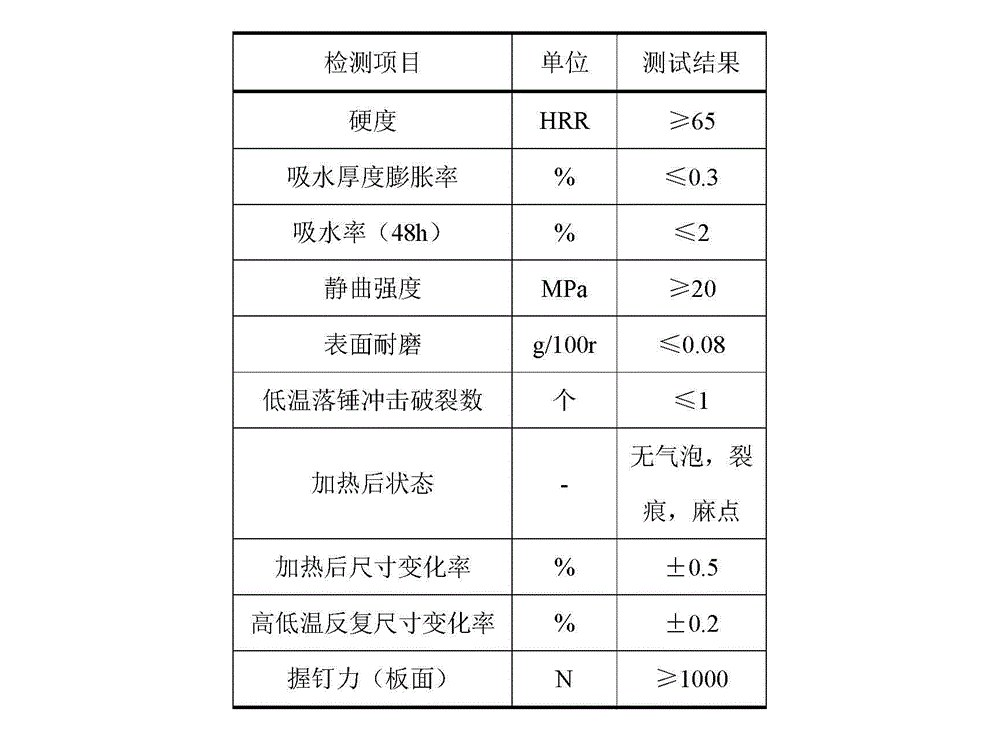Three-layer coextruded PVC (polyvinylchloride) wood-plastic composite foam board and preparation method thereof
A wood-plastic composite, three-layer co-extrusion technology, applied in chemical instruments and methods, layered products, synthetic resin layered products, etc., to achieve the effects of excellent nail holding force, good dimensional stability, and high surface hardness
- Summary
- Abstract
- Description
- Claims
- Application Information
AI Technical Summary
Problems solved by technology
Method used
Image
Examples
preparation example Construction
[0056] The steps of the preparation method of the three-layer co-extruded PVC wood-plastic composite foam board are: according to the proportion, weigh the raw materials of each component respectively and add them to the high-speed mixer, start at low speed after sealing, and adjust to high speed after 5 minutes, When the material reaches 115℃~125℃, open the material door and put it into the low-speed pot, cool to about 30℃ and release it.
[0057] The uniformly mixed material is put into the hopper of the extruder through the automatic screw feeder, and at the same time, the temperature of the extruder is preset and kept warm, and the raw material is melted and plasticized by the extruder. It is co-extruded by the main machine and the auxiliary machine, extruded into the shaping device through a special mold, cooled and shaped, and pulled out by traction, and then enters the automatic cutting machine to automatically cut to the stacking rack according to the preset length, and...
Embodiment 1
[0060] Outer layer (layer A): 43% polyvinyl chloride, 19% filler, 2.7% impact modifier, 0.8% lubricant, 3% composite stabilizer, 0.3% coupling agent, 1.1% processing aid, Polyvinyl chloride recycled material 30.1%.
[0061] Inner layer (layer B): 50% polyvinyl chloride, 4% wood fiber powder, 10% filler, 0.2% foaming agent, 6% reinforcing agent, 5% foaming regulator, and 2% impact modifier , 0.85% internal lubricant, 2.1% composite stabilizer, and 19.85% sheet recycled material.
[0062] According to the proportion, weigh the raw materials of each component and add them to the high-speed mixer. After sealing the cover, start at low speed and adjust to high speed after five minutes. When the material reaches 115°C-125°C, open the material door and put it into the low-speed pot. Cool to Release at around 30°C. The uniformly mixed material is put into the hopper of the extruder through the automatic screw feeder, and at the same time, the temperature of the extruder is preset an...
Embodiment 2
[0064] Outer layer (layer A): 48% polyvinyl chloride, 19% filler, 2.5% impact modifier, 0.8% lubricant, 3.2% composite stabilizer, 0.3% coupling agent, 1.1% processing aid, Polyvinyl chloride recycled material 25.1%.
[0065] Inner layer (layer B): 55% polyvinyl chloride, 4% wood fiber powder, 8% filler, 0.2% foaming agent, 5.5% reinforcing agent, 5.2% foaming regulator, and 2% impact modifier , 0.85% lubricant, 2.3% composite stabilizer, and 16.95% sheet recycled material.
[0066] According to the proportion, weigh the raw materials of each component and add them to the high-speed mixer. After sealing the cover, start at low speed and adjust to high speed after five minutes. When the material reaches 115°C-125°C, open the material door and put it into the low-speed pot. Cool to Release at around 30°C. The uniformly mixed material is put into the hopper of the extruder through the automatic screw feeder, and at the same time, the temperature of the extruder is preset and ke...
PUM
| Property | Measurement | Unit |
|---|---|---|
| thickness | aaaaa | aaaaa |
| thickness | aaaaa | aaaaa |
| impact strength | aaaaa | aaaaa |
Abstract
Description
Claims
Application Information
 Login to View More
Login to View More - R&D
- Intellectual Property
- Life Sciences
- Materials
- Tech Scout
- Unparalleled Data Quality
- Higher Quality Content
- 60% Fewer Hallucinations
Browse by: Latest US Patents, China's latest patents, Technical Efficacy Thesaurus, Application Domain, Technology Topic, Popular Technical Reports.
© 2025 PatSnap. All rights reserved.Legal|Privacy policy|Modern Slavery Act Transparency Statement|Sitemap|About US| Contact US: help@patsnap.com

